From the April 2021 issue of Apollo. Preview and subscribe here.
In the summer of 1936, when Salvador Dalí gave his famous lecture at the International Surrealist Exhibition in London, delivered wearing a diving suit, he was accompanied by his friend and patron Edward James (1907–84). The pair had gone to Siebe Gorman & Co. to buy the apparatus and, when asked by the shop assistant how deep he was planning to go, Dalí replied, ‘The depths of the subconscious!’ He arrived at the New Burlington Galleries wearing the enormous copper helmet, with a jewelled dagger in his belt, a billiard cue in one hand and leashes attached to two borzois in the other. When he began to asphyxiate mid-manifesto, which James was translating, his fellow artists tried to free him, unsuccessfully, with a spanner. The billiard cue was used to lever off the helmet instead and the audience applauded, sure that the performance was a well-rehearsed Surrealist stunt.
James, the heir to an American railway fortune, already owned four important paintings by Dalí, whom he had met in Paris the year before, and from 1937–38 had a contract with Dalí to acquire his entire output in exchange for a generous stipend. The duo took Metamorphosis of Narcissus (1937), a masterpiece of Dalí’s ‘paranoiaccritical’ period, over whose creation James had presided like a ‘midwife’, to show the patron saint of Surrealism, Sigmund Freud, then in exile in London. ‘Why the ants?’ Freud asked, unimpressed. Several of James’s paintings by Dalí were later confiscated in France by the Nazis. One of the few to be saved was Swans Reflecting Elephants (1937) – a title James borrowed for his memoir – which, when it reached him, bore the mark of a bullet hole. Nevertheless, by the outbreak of war, James had amassed one of the most important collections of modern art in the world. He owned work by Jean Arp, De Chirico, Duchamp, Ernst, Fini, Carrington, Giacometti, Klee, Man Ray, Miró, Paul Nash, Noguchi, Picasso, Dalí, Magritte, Rex Whistler and Pavel Tchelitchew.
The drawing room at Monkton House, featuring a pair of ‘Lips’ sofas (1938–39) and ‘Champagne standard lamps (1938) designed by Salvador Dalí and Edward James (photo: 2006). Photo: Elizabeth Whiting & Associates/Alamy Stock Photo
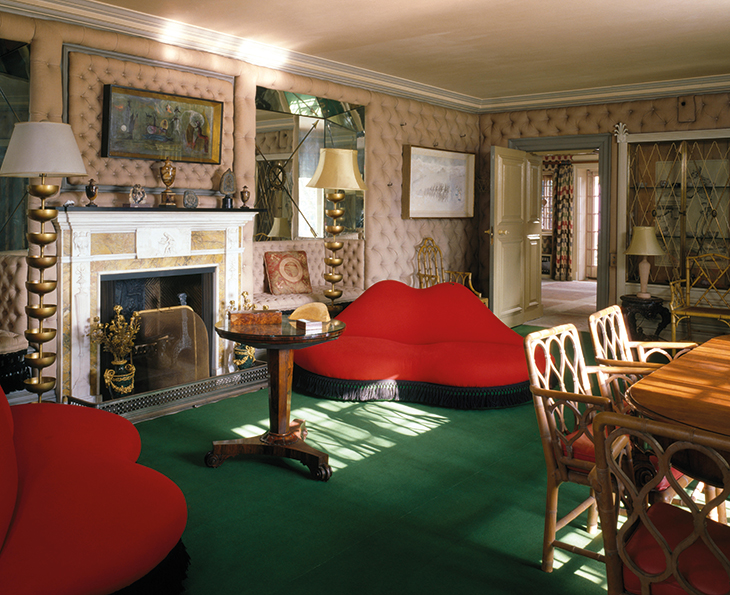
On a trip to Berlin in 1929, taking advantage of runaway inflation, James bought his first work, Allegory of Air by Jan Brueghel the Elder, for only £300. He liked to say that, having failed to find more Old Masters at such prices, he began to patronise contemporary artists. However, he didn’t consider himself a collector, but a fellow creative and collaborator, even though his early literary endeavours were ridiculed by the likes of the poet Stephen Spender: ‘Mr James has too many possessions: pictures by Picasso, estates in England, villas on the Riviera, yachts and aeroplanes. He also thinks he can buy the gift of being a poet’ (James never published poetry under his own name again). With functionaries to take care of his financial affairs, James set himself the task of shedding his great inheritance and made that a kind of art in itself. ‘Money seemed to have been given to spend,’ he wrote to the actress Ruth Ford in 1941. ‘I felt that I could do more to alter the face of the world, more to usher in that new world, by spending it in my own way – in particular, by fostering any and all creative spirits I could meet with, who had something individually to contribute to the building of that more vivid and more living future.’
Edward James (1907–84) photographed in 1933 at his London home in Wimpole Street with a painting by Pavel Tchelitchew. Photo: Sasha/Hulton Archive/Getty Images

In his Diary of a Genius (1963), Dalí declared himself to have been a Surrealist ‘from birth’, a claim that James also adopted. He grew up at West Dean, his family’s huge estate in Sussex, surrounded by liveried servants and his father’s hunting trophies, including an enormous polar bear shot in Greenland (he would later give it to Dalí, who had it dyed mauve, and put cutlery drawers in its moth-eaten chest). Rumour had it that James was the illegitimate son of his godfather Edward VII, who was a frequent visitor; James preferred to think he was his grandson, and that it was his grandmother, who grew up on an estate neighbouring Balmoral, who had a tumble in the heather. His mother once gifted herself to the King in a box, dressed as a doll, inviting him to wind her up, before performing a dance like Dr Coppélius’s ‘daughter’.
At Oxford, flush with the inheritance from both his father and uncle (the latter had been killed by an African elephant), he was part of the Brideshead generation of ‘Bright Young Things’, and developed a dilettantish interest in the arts, especially poetry. He decorated his Christ Church rooms with Flemish tapestries, silk-lined walls and a purple ceiling and frieze, banded with a quotation James attributed to Seneca in gold lettering: ARS LONGA VITA BREVIS SED VITA LONGA SI SCIAS UTI (Art is long and life is short, but life, if you know how to use it, can also be long). He financed Cherwell, a university publication, and began the James Press, which published luxurious editions of his poetry and the first book by his close friend John Betjeman. He never graduated, taking up a job as a junior diplomat in Rome, the only employment he ever had, where – with his Rolls-Royce and palazzo on the Tiber – he lived in greater luxury than the ambassador. After several months, he was fired after nearly causing a diplomatic incident with a mistranscribed cable.
Footprint carpet installed in West Dean House in 1950. Photo courtesy West Dean College of Arts and Conservation
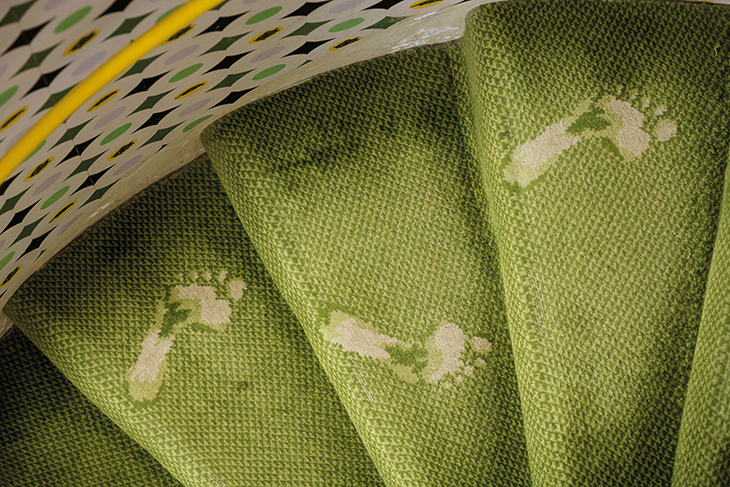
By then, he had fallen hopelessly in love with the Viennese actress Tilly Losch, whom he had first encountered when he was still at Oxford and she was starring in Noël Coward’s revue This Year of Grace (1928). He had been particularly entranced by a number that had her assuming the postures of gothic sculpture. She had high cheekbones, hypnotic, green eyes, and beautiful and expressive hands that she made full use of in her performances. James’s mother, who died the following year, had warned him not to marry an actress, which perhaps added to the attraction. He pursued Losch to New York, and they wed in 1931, but she didn’t return to England, as he’d hoped, to become the chatelaine of West Dean, but stayed in Manhattan to star in The Band Wagon opposite Fred Astaire. It was, as Cecil Beaton put it, a ‘fiascotic marriage’; she was serially unfaithful, and cheated on him with his close friends Randolph Churchill and Tom Mitford, before beginning an affair with Serge Obolensky, an émigré Russian prince.
James devised an elaborate scheme to win her back. He funded George Balanchine’s company Les Ballets 1933, an idea suggested to him by Coco Chanel, on the condition that a role was created for Losch, who had trained with the Vienna Opera Ballet. She did indeed return to Paris to star in the review, dancing one ballet in a salamander green dress with a 15-foot-long train designed by Pavel Tchelitchew, and in another, The Seven Deadly Sins, which James persuaded Bertolt Brecht and Kurt Weill to write, opposite Lotte Lenya. When the latter transferred to the Savoy Theatre in London, James redecorated his Wimpole Street house to please her, incorporating a modernist chrome and black bathroom designed by Paul Nash, with an electric heater and a ballet barre; he also commissioned a special Rolls-Royce, with a double bed, to transport her to West Dean after performances. The ballet cost him £100,000 (he claimed to have spent the same on jewels for his wife at Cartier) but his grand gesture was ultimately unsuccessful.
Monkton House on the West Dean Estate in West Sussex, photographed in 1972. Photo: Tony Evans/Timelapse Library/Getty Images
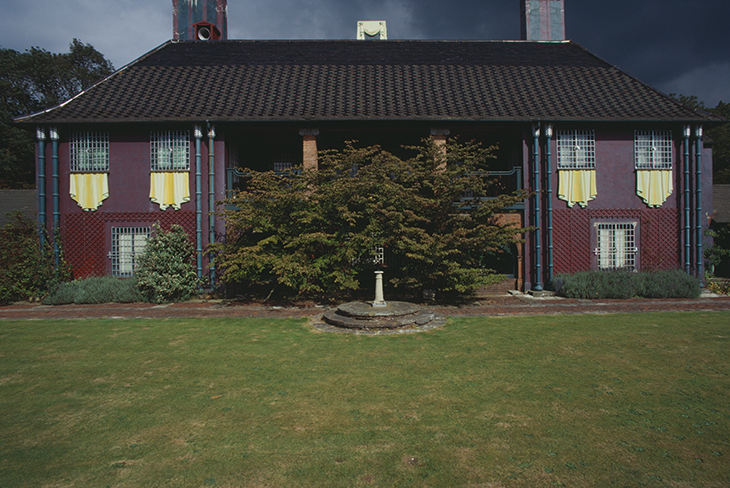
James divorced Losch in 1934, accusing her of adultery with Obolensky; her countersuit, in which she accused him of being homosexual, failed. In the code of the time, his aggressive stance was considered ungentlemanly, and his friends peeled away. At West Dean, abandoned, he had a psychotic episode, in which he saw the whole of creation eddying around a central light, to a speeded-up version of Beethoven’s Eroica symphony, before exploding into the sky – an experience he wrote about in his only published novel, The Gardener Who Saw God (1937). His friend Edith Sitwell helped him to rebuild his life, introducing him to Marie-Laure de Noailles, whom he visited in her modernist house in Hyères, furnished by Eileen Gray, where Dalí and Luis Buñuel had stayed when they wrote L’Âge d’Or. The Vicomtesse de Noailles and her husband were great patrons of modern art: ‘She was the great grand-daughter of the Marquis de Sade,’ James noted, ‘so the Surrealists didn’t mind sponging off her’. He admired Dalí’s portrait of De Noailles, with whom he started an affair (she slipped into his bed, ‘like a moonbeam’, he said), and was introduced to the Spanish artist.
At the end of 1935, James abandoned West Dean and focused his energies on Monkton House, the Lutyens shooting lodge that had been built for his parents on the estate in 1902. Finding the Arts and Crafts style too ‘cottagey’, he set about totally redesigning it with his new Surrealist friend. Dalí had recommended James’s London house have walls that heaved like a sick dog’s stomach, and James had planned to cover them in dog hair. At Monkton, the walls were padded as in an asylum, and wet paw prints replaced those of Losch on the carpets decorating the sweeping stair and corridors (his wolfhounds were more faithful than she was, James joked). The master’s bed was modelled on Nelson’s hearse, and planets shone through the alabaster walls of his bathroom. At James’s suggestion, Dalí designed sofas based on the lips depicted in his collage Mae West’s Face Which May Be Used as a Surrealist Apartment (1934–35) and the ‘Hands’ chair, and James also oversaw the creation by Green & Abbott of his famous lobster phones and lamps made of stacks of bronzed champagne coupes. He added plaster aprons to the windows, like sheets hanging to dry, mock bamboo downpipes, and a clock tower which told only the day of the week; wooden palms flanked the pink door case, and the facade was painted a metallic purple. James’s biographer Philip Purser described the effect of the most important Surrealist house in Britain as resembling ‘a mad potentate’s private brothel’.
‘Hands Chair’ (1938) designed by Salvador Dalí and photographed at Monkton House. West Dean Collection. Photo courtesy West Dean College of Arts and Conservation

Dalí introduced James to René Magritte, who stayed with him for a summer in London. The Belgian artist completed a series of paintings for James’s Vogue Regency dining room in Wimpole Street, which were to be displayed hidden behind mirrors with lunettes by Boucher depicting the four seasons, and revealed only when illuminated from within. Magritte also made two portraits of James. Not to Be Reproduced (1937) shows James from behind looking into a mirror, in which he is reflected, with carefully coiffed hair, also from behind. One is reminded of Losch’s first encounter with James, sitting behind him at a cinema, when she apparently found the back of his head ‘appealing’. For his amanuensis, George Melly, it was illustrative of his ‘obsessional reticence’, especially on the subject of his divorce. Another portrait, The Pleasure Principle (1937), shows James straight on, but he is no less visible, his head obscured by a bright light. At this time, James was financing the Surrealist publication Minotaure – featuring covers by Tchelitchew, Dalí and Picasso – which proved a temporary outlet for his own writing. Norman Parkinson photographed him at his Italianate desk in Wimpole Street, framed by huge swags of velvet, a Picasso pastel, Femme Assise au Chapeau (1923), behind him.
‘Edward is as insanely relentless as myself,’ Dalí wrote approvingly of their shared mission to Surrealise everyday life. They took the spirit of Monkton to New York for the 1939 World’s Fair, whose theme was ‘The World of Tomorrow’, where they created a pavilion, ‘Dream of Venus’, that showed a Surrealist carnival funhouse. You entered this outlandish coral reef through two stockinged legs, above which was a 25-foot version of Botticelli’s goddess, past a ticket booth that was an enormous pufferfish. Inside, topless mermaids swam in a huge tank through a Surrealist landscape, an underwater Pompeii complete with roaring fire; in another room lay a reclining Venus, her dreams enacted behind a mirror above the bed. James financed this operation, which brought Surrealism to the masses (it was promoted on the covers of Vogue and the New Yorker), but when the festival censors intervened, Dalí, by now world famous, disassociated himself from the project, writing his seminal pamphlet: ‘Declaration of the Independence of the Imagination and of the Rights of Man to His Own Madness’.
The hall at Monkton House containing La Comédie du Soir (1936) by Paul Delvaux (1897–1994). Photo: Elizabeth Whiting & Associates/Alamy Stock Photo
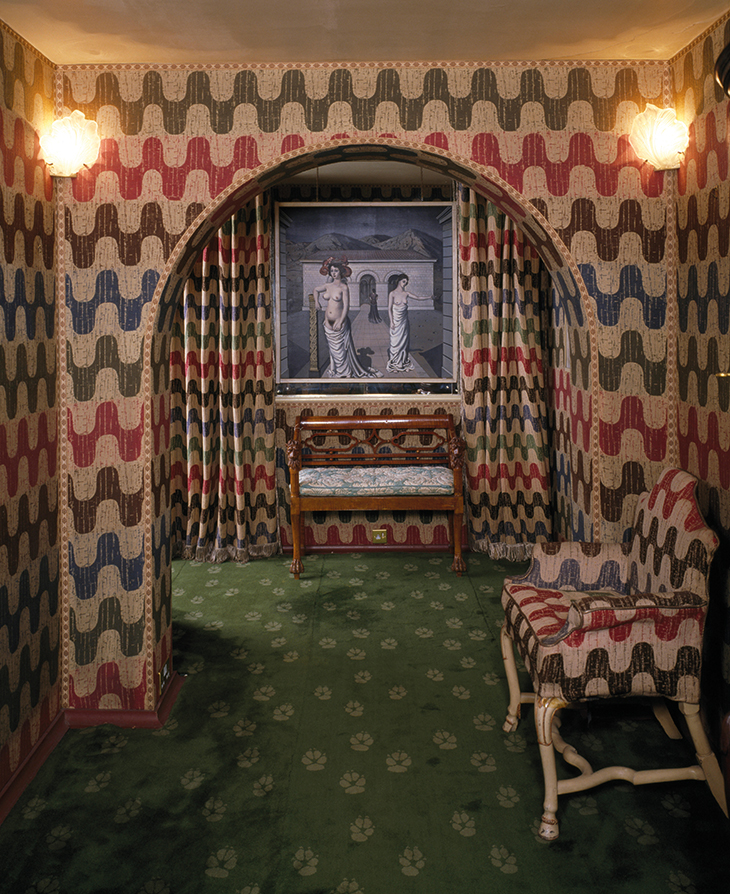
James spent the war in the United States, at first residing at the Taos art colony, the literary retreat in New Mexico started by Mabel Dodge, another wealthy patron of the arts, where D.H. Lawrence, Carl Jung, Ansel Adams and Georgia O’Keeffe had been guests. It was at Taos that Aldous Huxley had written Ends and Means (1937), a book that set out a plan for the rebirth of Western civilisation and was to have a lasting influence on James; he followed Huxley and his friend Gerald Heard to California, and also became involved in the Vedanta movement, practicing meditation, vegetarianism, and consciousness development. Huxley suggested that individuals with financial means should create models for new ways of living, which gave James the initial idea of turning West Dean into an artist’s colony. In 1964 he established the Edward James Foundation, and in 1971 founded West Dean College, devoted to conservation and the historic craft practices that James feared might be lost to humanity. Begrudgingly, in its early years, he sold some of his Surrealist masterpieces to keep it afloat: ‘I didn’t give away my inheritance so that a middle-class couple, bored of watching television, could spend a weekend learning to make corn dollies for less than it would cost them to stay at a hotel in Torquay,’ he complained.
By that time, James was spending an increased amount of time in Mexico, which was according to André Breton, who visited in 1938, ‘the Surrealist place par excellence’, a country where ‘reality had surpassed its splendour already promised in dreams’. James travelled the country with his ‘secretary’ Plutarco Gastélum, a young Mexican of indigenous heritage, before buying a swathe of tropical rainforest in Xilitla, five hours north of Mexico City. There he set himself up like Noah, or Dr Doolittle, a germophobe who surrounded himself with toucans, macaws and a menagerie of other animals that he sometimes took with him to his Mexico City hotel, once renting an adjoining suite for his boa constrictors. Freed from the burden of West Dean, and having lost a crop of orchids to a freak frost, he started building a city of follies in the jungle, concrete poetry perhaps influenced by Watts Tower in Los Angeles, the outsider art palace that he had helped to save in the late 1950s, or his visit to the Mayan ruins at Chichén Itzá. His teetering, unfinished, Piranesi-like structures, made by an army of workers from his clumsy sketches, were, he said, ‘pure megalomania’. Now a tourist attraction, with a nearby museum devoted to Leonora Carrington, another rebel aristocrat who became his close friend in Mexico, these towers and cupolas are being swallowed by jungle like a Max Ernst frottage.
La Cinematografia under construction at Las Pozas, Xilitla (c. 1960). Edward James Archive. Photo courtesy West Dean College of Arts and Conservation
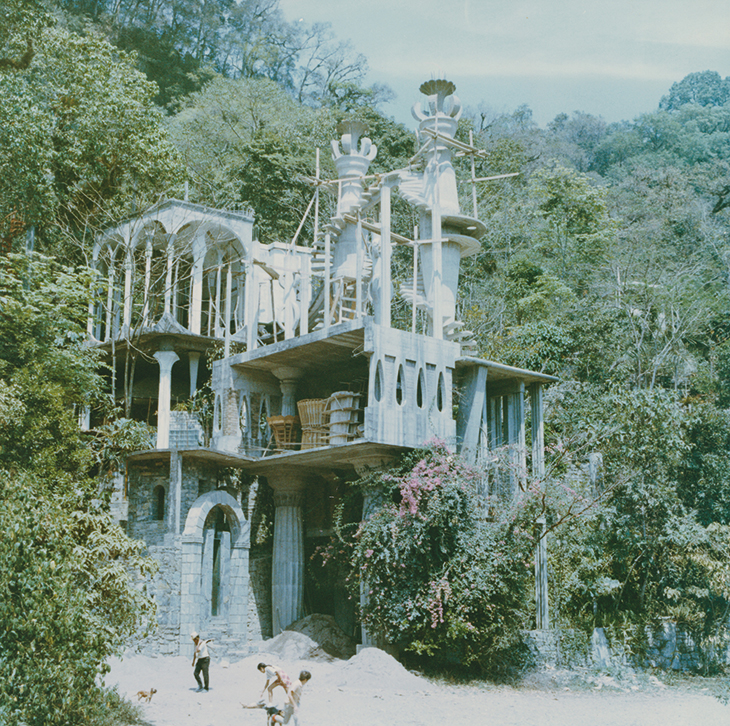
James intended Xilitla as a kind of monument, selling more of his collection to pay for it, and considered having his corpse set in plastic aspic by Parisian taxidermists Deyrolle and hung on chains in one of the waterfalls. James died in 1984, aged 77, and was buried at West Dean. His slate slab reads, ‘Edward James: Poet’. After his death, West Dean’s trustees had a huge sale of his collection at Christie’s to buttress the college’s endowment, and controversially, Monkton was also sold, despite a high-profile campaign to save the Surrealist Gesamtkunstwerk for the nation. In 2016, the college consolidated its collection and sold more works, including a Mae West lips sofa, and a pair of champagne lamps which, after an export stop, were acquired by the V&A; they will go on display in the new ‘Design: 1900 to Now’ galleries that open in June. Some of the most notable items from James’s astonishingly large collection are now to be found in institutions such as MoMA and the Tate. West Dean College, which celebrates its 50th anniversary this year, has a long-term plan to build a gallery to house the archive and the 341 works that James acquired which remain, all that is left of a life lived richly.
From the April 2021 issue of Apollo. Preview and subscribe here.


